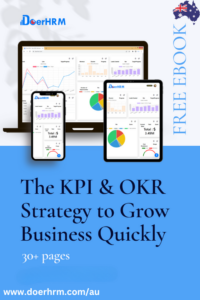When businesses are founded, they do it with growth in mind. Many businesses, from multibillion-dollar conglomerates to one-man startups, are always on the lookout for ways to expand their operations and boost their bottom line. In order to succeed in business, it is essential to increase productivity and use promotional strategies. The company’s greatest strength is its people, so it’s crucial that they have a good place to work if it wants to grow.
Managing employee performance well may have a positive influence on your business’s bottom line. The objective and key result (OKR) framework and Balanced Scorecards are two examples of evaluation systems used to assign employee grades. Both strategies focus on boosting morale throughout the group as a whole to increase efficiency.
What is Balanced Scorecards?
The Balanced Scorecard, or BSC for short, is a management tool that businesses use to define their goals, link their day-to-day operations to their long-term goals, decide which projects should take priority, and track their overall performance.
A balanced scorecard can be used to keep track of goals in four different ways. The Scorecard is made up of four parts that all work together. They are the Customer Aspect, the Financial Aspect, the Operational Aspect, and the Developmental Aspect. One of the options must be able to meet every possible “objective.” After figuring out what they want to do, users have to set “measures” to help them get there. Then, one must define a “initiative” and choose a good “indicator” of progress.
What is Objectives and Key Results?
The Objectives and Key Results (OKRs) framework is a useful and flexible way to set and reach high-level goals. OKRs are meant to make it easier to keep track of how a project is going.
Most of the time, OKRs are set up every three months, and for each user, team, or department, no more than three to five goals are set. The quarterly goals of a group are statements that are broad, ambitious, and easy to remember. Then, we use key Results to give these goals numerical values. For each goal, there shouldn’t be more than three to five key results. Key results must be measurable and part of a detailed list that, when completed, shows that the goal they are tied to has been reached.
OKRs vs BSCs
While both OKRs and BSCs aim to manage and monitor performance or productivity, they use quite different approaches. The key difference is in their strategies.
OKRs and BSCs both aim to manage and keep track of performance or productivity, but they do this in very different ways. And the difference is in how they fight.
A Balanced Scorecard is a strategy plan with 4 parts that helps you reach your goals. There are goals for all parts of the business, such as finances and customers, company operations, training and development, and so on. So, a BSC can have anywhere from 15 to 20 goals at the same time. How well an industry does depends on how well it moves toward its goals. It’s also a method that takes care of everything.
With BSC, the most important part is the financial side, and measurement parameters are made based on the financial side to answer these questions:
Financial goals: “What are our goals about money that will affect our group?”
Customers goals: “What do our customers value most, and how will that affect our finances?”
Internal process goals: “What do we have to do well on the inside to meet our customer goals, which will affect our finances?”
Learning and growth goals: “What skills, culture, and abilities do we need in our organisation to carry out the process that will make our customers happy and, in the end, have an effect on our finances?”
Once one of the four performance dimensions has been chosen, it is possible to set goals that are important and fit that performance dimension. The BSC framework is made up of four parts: indicators, objectives, measures, and measurement initiatives. BSCs are a key part of this paradigm. They work from the top down and focus on lagging metrics, like the financial benchmarks mentioned earlier.
OKRs, on the other hand, not only “cascade,” but they also “ladder.” That’s why they’re so focused on lagging indicators, or “input.”
Both BSCs and OKRs describe what needs to be done in pretty much the same way. On the other hand, Balanced Scorecards can have a lot more goals than OKRs.
BSCs can have up to fifteen goals at once, but we at DoerHRM think you should only have three to five.
In BSCs, the term “Key Results” means the same thing as “Measures.” OKRs let you have up to five key outcomes for each goal, but BSCs say you should only have two.
Initiatives are the things that need to be done to reach a Goal. Most businesses have many different projects for each goal. One example of a Learning and Growth goal would be to use a new app to do a survey of employee satisfaction.
OKRs are usually not limited by any one set of criteria when they are being made. OKRs give the team the freedom to choose its own priorities. BSCs, on the other hand, put more emphasis on being responsible for a set of activities that have already been decided upon. This is because they focus on results, such as financial goals. This means that people are actively encouraged to take risks.
Can BSCs and OKRs work together?
Yes, BSC can be used to add to OKRs, especially at the executive level. The BSC strategy map may help CEOs and other leaders come up with meaningful OKRs by putting the year’s priorities in a visual format.
One way to see how OKRs move through a company is by using a strategy map. A BSC strategy map is a good way to make sure that all of the top business people have talked to all of the employees. This is important because good companies try to have half of their goals come from the bottom up.
Then, OKRs use Key Results and CFRs to help an organisation measure how different groups’ priorities change over the next month or quarter. OKRs, on the other hand, make sure that strategies don’t get too big, that they have more specific and time-sensitive measures, and that they aren’t just output goals. BSC can help with all of these things.
OKRs or BSCs? Which will you choose?
For this purpose, the Balanced Scorecard and Objectives and Key Results are also helpful management tools. The situations in which they are used depend on their goals and how they are carried out. Some people think that OKRs are better for monthly or quarterly plans, while others think that BSCs are better for yearly or three-year goals. OKRs are a fairly new way to measure and track progress, but they are not meant to replace BSCs. If you use both models together, you will get the best results.
Start using DoerHRM now for free to see what our powerful software can do for your business, or schedule a demo to learn more about how we can help you prioritise your tasks, track your progress, and reach your goals with our flexible and scalable goal-setting software.









